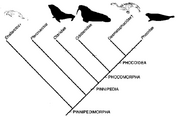
Walruses close up
Laptevi walruses in the wild

According to Freeman & Herron, the phylogenetic species concept focuses on lineages of monophyletic groups, in which they all originate from one common ancestor (2007). This PSC relies on narrowing a species down to the smallest monophylyl.
Examples of Monophylyl Species[]
The walrus population of today is divided into 3 subspecies, Odobenus rosmarus rosmarus, Odobenus rosmarus divergens, and O. r. Laptevi. The Laptevi population is of course isolated to the Laptev Sea and is believed by some to be genetically divergent from the other two groups. There is heated debate about whether these groups are reproductively isolated or not, as well as their genetic differences. The morphometric data shows insignificant size difference between the them, with the Laptev walrus being noted as the intermediate of the three. The minimal genetic data collected does show distinct monophyletic taxonomic status for both the Atlantic and Pacific walrus. There is not sufficient data to determine where O. laptevi fits into the phylogenetic tree (Lindqvist et al., 2009). Based on a genetic and morphological comparison it has been determined that the Laptev walrus are not yet isolated, but it is possible that eventually they can be genetically isolated (Lindqvist et al., 2009). However, it is more likely that with the loss of sea ice thanks to global warming, walrus migration will be far less isolating to the species. By learning more about how the Laptev walrus falls into the genetic evolutionary tree of Pinnipeds we can hopefully improve population management as well as migratory patterns. While much still needs to be done about global warming and how it's affecting the sea ice loss, this can only help our knowledge of the species.
Section heading[]
Write the second section of your page here.